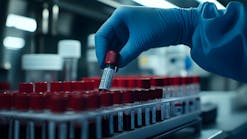A bloodstream infection, or sepsis, is a serious condition that impacts more than one million Americans annually. The mortality rate associated with bloodstream infections ranges from 10% to 40%, and has aggregate healthcare cost of approximately $16 billion a year.1,2 The gold-standard method for pathogen identification in bloodstream infections requires culturing patient blood in an automated continuous monitoring system followed by Gram stain and sub-culturing. A significant drawback to this method is that the time to positive organism identification may be 12 to more than 72 hours. Every hour appropriate treatment is delayed has been shown to increase mortality by 7%;3 therefore, earlier detection of the etiological agent has the potential to greatly benefit patient care. The guidelines for the Surviving Sepsis Campaign 2012 recommends administration of broad-spectrum antimicrobial therapy within one hour of septic shock recognition.4 After the causative pathogen has been identified, the most appropriate antimicrobial agent that is safe and cost-effective should be administered.
New diagnostic technologies have been developed that significantly reduce the time required to identify pathogens that cause bloodstream infections. Investigations using some of these technologies show reduced healthcare costs and increased administration of correct antimicrobials.5,6 This article will review the current state of these diagnostic technologies.
FISH
Fluorescent in situ hybridization (FISH) tests have been used in rapid bloodstream infection diagnosis for more than a decade.7 Fluorescently labeled oligonucleotide probes specific for ribosomal RNA have been designed for greater than 95% of pathogens typically associated with bloodstream infections; a number of these are approved by the United States Food and Drug Administration (FDA) for in vitro diagnostic (IVD) use.7-10 FISH tests have shown high levels of sensitivity and specificity.9-11 Each FISH reaction tests for a small number of pathogens; therefore multiple FISH reactions are required to cover all bloodstream infections. Each test has a reported hands-on time of five to15 minutes and a turnaround time of 30 to 145 minutes.10,12
PCR
Polymerase chain reaction (PCR) is used routinely in molecular diagnostic applications for infectious disease. Diagnostic PCR assays are typically performed by fully automated or semi-automated instruments, capable of simultaneously testing for a limited number of pathogens in multiple samples. Recently, highly multiplexed PCR tests have been developed that identify large panels of pathogens and antibiotic resistance genes for bloodstream infections.
PCR tests that detect pathogens in whole blood have been developed for manual use.13-15 While manual tests can detect the majority of pathogens that cause bloodstream infections, they require significant hands-on time and skilled users familiar with molecular biology techniques. Additionally, the assay sensitivity is probably too low to detect some pathogens at physiologically relevant titers in blood.16,17 Taken together, these factors will likely hinder widespread adoption of manual PCR tests for pathogen detection in whole blood. To our knowledge, the FDA has not cleared an IVD with the intended use of directly detecting pathogens that cause sepsis in blood.
To circumvent problems associated with detecting low level pathogens in blood, PCR-based diagnostics were developed that detected pathogens in blood culture (BC). Detecting pathogens from BC is less challenging than direct detection from whole blood because pathogen titers are enriched through culturing.18 For example, a low multiplex, fully automated PCR test was developed that detects methicillin-resistant and -sensitive Staphylococcus aureus in BC.19 This test is more user-friendly and requires less time to perform compared to manual tests but is limited to detecting a small number of targets. For sepsis, diagnostic tests with higher multiplex capabilities are preferable to lower multiplex tests because approximately 20 to 25 pathogen species are responsible for more than 90% of bloodstream infections;20,21 therefore, diagnostics capable of detecting 20 to 30 targets would be well suited to identify the majority of targets relevant to infection.
Currently, a highly multiplexed, user-friendly PCR test for detecting a panel of 27 targets in BC is in development.22 This test utilizes two different PCR reactions. The first PCR reaction is highly multiplexed, containing greater than 60 primer sets. It functions to enrich a second, nested PCR reaction. The second reaction contains specific primer sets for each target. Developers of this design assert that it offers the key advantage of being able to detect a broad range of targets, including gram-positive and gram-negative bacteria, fungi, and antibiotic resistance targets. They further note that its high multiplex design allows for simultaneous detection of multiple pathogens in a polymicrobial BC. This automated, sample-to-result system tests one sample at a time. Sample purification, PCR detection, and results interpretation are performed by the same instrument in about one hour, with less than five minutes of hands-on time required for setup.23
Microarray
Microarray-based applications have had less of an impact in clinical settings than in the research community, although this trend may be changing. Technological advances directed at simplifying workflows and shortening time-to-result are making microarray applications more practical for clinical use. For bloodstream infections, microarray technology has recently been developed to identify panels of pathogens in BC. A microarray-based IVD for detecting a panel of gram-positive bacteria and antibiotic resistance targets in BCs was cleared by the FDA in 2012, and another test for identifying gram-negative bacteria in BCs is currently in development.24 These tests are automated and random-access, and require less than five minutes of hands-on time.
MALDI-TOF
MALDI-TOF mass spectrometry (MS) analysis is a recent addition to bloodstream infection diagnosis. This platform functions by ionizing biomolecules (i.e., nucleic acids, proteins, saccharides) through an electric field and separating them according to their mass to charge (m/z) ratio. The m/z ratio of each biomolecule is then compared to a reference library database to determine which organism is present. The accuracy of detection relies on specialized reference libraries. MALDI-TOF MS has been utilized to detect gram-negative, gram-positive, and fungal pathogens associated with bloodstream infection.25-29 This technology is still in development, and no FDA cleared IVD tests are available.
Some of the benefits of MALDI-TOF MS are the rapid time-to-results and the broad detection potential. Reported time-to-results from when a blood culture is detected positive for growth by continuous monitoring systems to organism identification range from 20 to 70 minutes.5 When incorporated in a clinical setting, this rapid time-to-result reduced the median time to species identification compared to standard sub-culturing methods by 28.8 hrs.5 The broad detection potential of MALDI-TOF MS was illustrated in a recent investigation in which 1,660 different bacterial isolates recovered from blood, cerebrospinal fluid, pus, biopsy, respiratory tract, wound, and stool specimens were analyzed. Isolates were tested after appropriate sub-culturing. Of these isolates, 1,397 (84.1%) yielded the correct species identification, and 189 (11.3%) were identified at the genus level.30
While MALDI-TOF MS exhibits broad-spectrum potential from bacterial cultures, this technology currently exhibits reduced sensitivity for gram-positive bacteria and polymicrobial infections in blood cultures compared to conventional methods. Reported species level identification of Staphylococcus (non-aureus), Enterococcus, and Streptococcus isolates in single pathogen bloodstream infections ranged from 24% to 96.7%, 50% to 70.6%, and 31.8% to 50% respectively.28,31,32 Identification to genus level was slightly improved (71.9% to 84%, 75% to 76.5%, and 50% to 95.4% respectively). Polymicrobial infections, which have been reported to occur 6% to 15% of the time,33 are problematic for complete MALDI-TOF MS resolution. Frequently one of the bacteria in the sample can be detected, but seldom are multiple pathogens identified.26,29, 34 Pathogen identification by MALDI-TOF MS for these samples will likely result in frequent false-negative results and potentially inadequate patient treatment.
Sequencing
Over the last decade, technological advances have dramatically increased throughput and speed while reducing costs associated with DNA sequencing35 and, increasingly, microbiologists are using these technologies for research involving pathogen whole genome sequencing (WGS). Several epidemiologic studies have been published that employ WGS to map pathogen transmission patterns within healthcare settings and across geographical areas.36 In clinical microbiology laboratories (as opposed to the research-use arena), limitations involving sample preparation, turnaround time, and data interpretation have hindered adoption of DNA sequencing as a tool for diagnosing infections. A version of molecular inversion probe technology used in combination with next generation sequencing has been developed that identifies a group of twelve pathogens and an extensive panel of antibiotic resistance genes in BC in twelve hours.37 Newer sequencers that use nanopore biosensors may be able to further reduce turnaround time for bacterial genomes to two hours.35 Nevertheless, while technological advances in DNA sequencing have made it more practical for research use, improvements are still needed to make it feasible as a clinical diagnostic tool.
Technological advances in bloodstream infection diagnostics will continue to improve patient care while simultaneously improving the clinical laboratory workflow. This will be achieved through decreasing hands-on time, reducing time-to-result, increasing the potential for diagnostic multiplexing, and developing FDA-cleared, clinically actionable diagnostic applications.
is a scientist with BioFire Diagnostics. He joined BioFire’s sample preparation team in 2009 and also has helped develop the FilmArray System.
References
- Agency for Healthcare Research and Quality, U.S. Department of Health & Human Services, HCUPnet is a free, on-line query system, providing access to health statistics and information on hospital inpatient and emergency department utilization. HCUPnet. n.d. [cited 2013 February 20]. Available from: http://hcupnet.ahrq.gov/HCUPnet.
- Angus DC, Linde-Zwirble WT, Lidicker J, Clermont G, Carcillo J, Pinsky MR. Epidemiology of severe sepsis in the United States: analysis of incidence, outcome, and associated costs of care. Crit Care Med. 2001;29(7):1303-1310.
- Kumar A, Roberts D, Wood KE, et al. Duration of hypotension before initiation of effective antimicrobial therapy is the critical determinant of survival in human septic shock. Crit Care Med. 2006;34(6):1589-1596.
- Dellinger RP, Levy MM, Rhodes A, et al. Surviving sepsis campaign: international guidelines for management of severe sepsis and septic shock, 2012. Intensive Care Med. 2013;39(2):165-228.
- Vlek AL, Bonten MJ, Boel CH. Direct matrix-assisted laser desorption ionization time-of-flight mass spectrometry improves appropriateness of antibiotic treatment of bacteremia. PLoS ONE. 2012;7(3):e32589.
- Forrest GN, Mankes K, Jabra-Rizk MA, et al. Peptide nucleic acid fluorescence in situ hybridization-based identification of Candida albicans and its impact on mortality and antifungal therapy costs. J Clin Microbiol. 2006;44(9):3381-3383.
- Kempf VA, Trebesius K, Autenrieth IB. Fluorescent in situ hybridization allows rapid identification of microorganisms in blood cultures. J Clin Microbiol. 2000;38(2):830-838.
- Jansen GJ, Mooibroek M, Idema J, Harmsen HJ, Welling GW, Degener JE. Rapid identification of bacteria in blood cultures by using fluorescently labeled oligonucleotide probes. J Clin Microbiol. 2000;38(2):814-817.
- Hall L, Le Febre KM, Deml SM, Wohlfiel SL, Wengenack NL. Evaluation of the Yeast Traffic Light PNA FISH probes for identification of Candida species from positive blood cultures. J Clin Microbiol. 2012;50(4):1446-1448.
- Deck MK, Anderson ES, Buckner RJ, et al. Multicenter evaluation of the Staphylococcus QuickFISH method for simultaneous identification of Staphylococcus aureus and coagulase-negative staphylococci directly from blood culture bottles in less than 30 minutes. J Clin Microbiol. 2012;50(6):1994-1998.
- Wilson DA, Joyce MJ, Hall LS, et al. Multicenter evaluation of a Candida albicans peptide nucleic acid fluorescent in situ hybridization probe for characterization of yeast isolates from blood cultures. J Clin Microbiol. 2005;43(6):2909-2912.
- Chapin K, Musgnug M. Evaluation of three rapid methods for the direct identification of Staphylococcus aureus from positive blood cultures. J Clin Microbiol. 2003;41(9):4324-4327.
- LightCycler® SeptiFast Test MGRADE. Roche Web site. http://molecular.roche.com/assays/Pages/LightCyclerSeptiFastTestMGRADE.aspx. Accessed May 3, 2013.
- Sepsis PCR Diagnostics—Sepsitest™ CE IVD. Novo Healthcare Ltd. Web site. http://www.novodx.net/pdf/Novo_Sepsitest.pdf. Accessed May 3, 2013.
- Magicplex™ Sepsis Real-time Test. Seegene Web site. http://www.seegene.com/en/magic/Sepsis_010.php. Accessed May 3, 2013.
- Westh H, Lisby G, Breysse F. Multiplex real-time PCR and blood culture for identification of bloodstream pathogens in patients with suspected sepsis. Clin Microbiol Infect. 2009;15(6):544-551.
- Kellogg JA, Manzella JP, Bankert DA. Frequency of low-level bacteremia in children from birth to fifteen years of age. J Clin Microbiol. 2000;38(6):2181-2185.
- Garrone MB, Amiott E, Dastrup E, McNeil S, McCarthy V, Carter C, Alger KNG, Thatcher S. Rapid identification of pathogens in positive aerobic blood cultures. journal of molecular diagnostics. 2012;14:686.
- Detection of Life Threatening MRSA and SA in Positive Patient Blood Culture Bottles in About an Hour—Cepheid Xpert® MRSA/SA BC Brochure. Cepheid Web site. http://www.cepheid.com/media/files/brochures/Xpert%20MRSA-SA%20BC%20US%200259-04%20LOR.pdf. Accessed May 3, 2013.
- Edmond MB, Wallace SE, McClish DK, Pfaller MA, Jones RN, Wenzel RP. Nosocomial bloodstream infections in United States hospitals: a three-year analysis. Clin Infect Dis. 1999;29(2):239-244.
- Biedenbach DJ, Moet GJ, Jones RN. Occurrence and antimicrobial resistance pattern comparisons among bloodstream infection isolates from the SENTRY Antimicrobial Surveillance Program (1997-2002). Diagn Microbiol Infect Dis. 2004;50(1):59-69.
- Blaschke AJ, Heyrend C, Byington CL, et al. Rapid identification of pathogens from positive blood cultures by multiplex polymerase chain reaction using the FilmArray system. Diagn Microbiol Infect Dis. 2012;74(4):349-355.
- FilmArray System. FilmArray Web site. http://www.filmarray.com/the-filmarray-system/ Accessed May 3, 2013.
- Nanosphere gram-positive and gram negative blood culture tests. Nanosphere Web site. http://www.nanosphere.us/product/gram-positive-blood-cultures, http://www.nanosphere.us/product/gram-negative-blood-culture. Accessed May 3, 2013.
- Stevenson LG, Drake SK, Murray PR, Rapid identification of bacteria in positive blood culture broths by matrix-assisted laser desorption ionization-time of flight mass spectrometry. J Clin Microbiol. 2010;48(2):444-447.
- Moussaoui W, Jaulhac B, Hoffmann AM, et al. Matrix-assisted laser desorption ionization time-of-flight mass spectrometry identifies 90% of bacteria directly from blood culture vials. Clin Microbiol Infect. 2010;16(11):1631-1638.
- Kok J, Thomas LC, Olma T, Chen SC, Iredell JR. Identification of bacteria in blood culture broths using matrix-assisted laser desorption-ionization Sepsityper and time of flight mass spectrometry. PLoS ONE. 2011;6(8):e23285.
- Ferreira L, Sanchez-Juanes F, Porras-Guerra I, et al. Microorganisms direct identification from blood culture by matrix-assisted laser desorption/ionization time-of-flight mass spectrometry. Clin Microbiol Infect. 2011;17(4):546-551.
- Buchan BW, Riebe KM, Ledeboer NA. Comparison of the MALDI Biotyper system using Sepsityper specimen processing to routine microbiological methods for identification of bacteria from positive blood culture bottles. J Clin Microbiol. 2012;50(2):346-352.
- Seng P, Drancourt M, Gouriet F, et al. Ongoing revolution in bacteriology: routine identification of bacteria by matrix-assisted laser desorption ionization time-of-flight mass spectrometry. Clin Infect Dis. 2009;49(4):543-551.
- Prod'hom G, Bizzini A, Durussel C, Billie J, Greub B. Matrix-assisted laser desorption ionization-time of flight mass spectrometry for direct bacterial identification from positive blood culture pellets. J Clin Microbiol. 2010;48(4):1481-1483.
- Ferroni A, Suarez S, Beretti JL, et al. Real-time identification of bacteria and Candida species in positive blood culture broths by matrix-assisted laser desorption ionization-time of flight mass spectrometry. J Clin Microbiol. 2010;48(5):1542-1548.
- Reimer LG, Wilson ML, Weinstein MP. Update on detection of bacteremia and fungemia. Clin Microbiol Rev. 1997;10(3):444-465.
- Drancourt M. Detection of microorganisms in blood specimens using matrix-assisted laser desorption ionization time-of-flight mass spectrometry: a review. Clin Microbiol Infect. 2010;16(11):1620-1625.
- Didelot X, Bowden R, Wilson DJ, Peto TE, Crook DW. Transforming clinical microbiology with bacterial genome sequencing. Nat Rev Genet. 2012;13(9):601-612.
- Chan JZ, Pallen MJ, Oppenheim B, Constantinidou C. Genome sequencing in clinical microbiology. Nat Biotechnol. 2012;30(11):1068-1071.
- User Guide HAI™ BioDetection Kit. Pathogenica Web site. http://www.pathogenica.com/documents/HAI_Biodetection_Kit_User_Guide.pdf. 2012. Accessed May 3, 2013.







